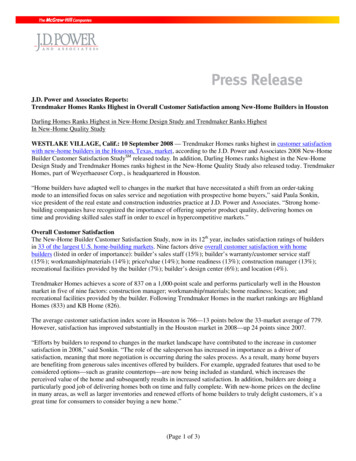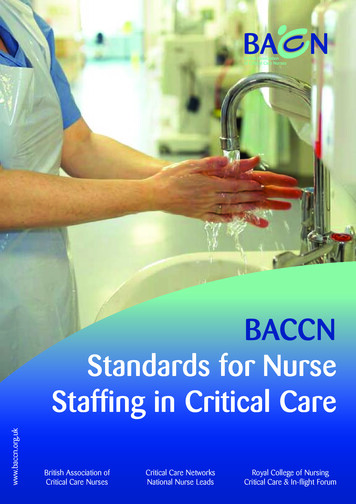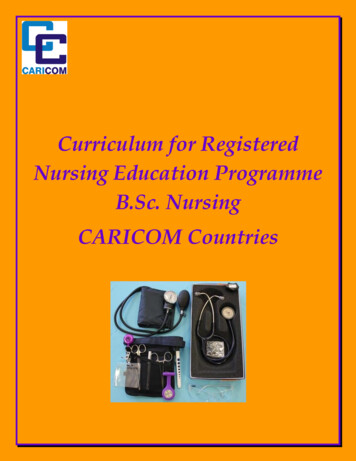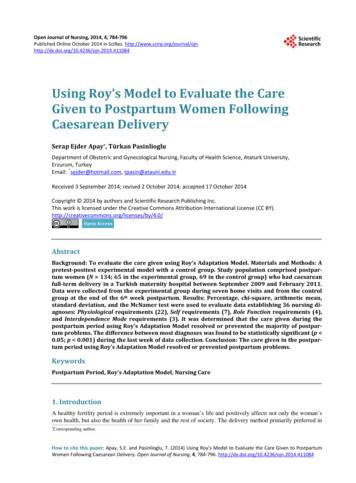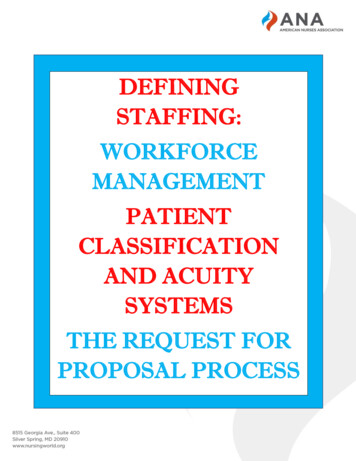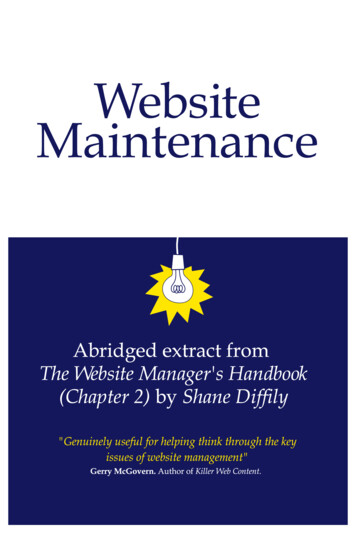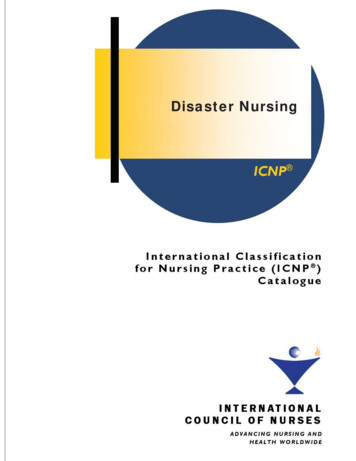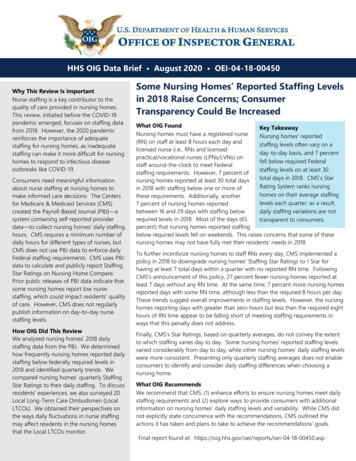
Transcription
HHS OIG Data Brief August 2020 OEI-04-18-00450Why This Review Is ImportantNurse staffing is a key contributor to thequality of care provided in nursing homes.This review, initiated before the COVID-19pandemic emerged, focuses on staffing datafrom 2018. However, the 2020 pandemicreinforces the importance of adequatestaffing for nursing homes, as inadequatestaffing can make it more difficult for nursinghomes to respond to infectious diseaseoutbreaks like COVID-19.Consumers need meaningful informationabout nurse staffing at nursing homes tomake informed care decisions. The Centersfor Medicare & Medicaid Services (CMS)created the Payroll-Based Journal (PBJ)—asystem containing self-reported providerdata—to collect nursing homes’ daily staffinghours. CMS requires a minimum number ofdaily hours for different types of nurses, butCMS does not use PBJ data to enforce dailyFederal staffing requirements. CMS uses PBJdata to calculate and publicly report StaffingStar Ratings on Nursing Home Compare.Prior public releases of PBJ data indicate thatsome nursing homes report low nursestaffing, which could impact residents’ qualityof care. However, CMS does not regularlypublish information on day-to-day nursestaffing levels.How OIG Did This ReviewWe analyzed nursing homes’ 2018 dailystaffing data from the PBJ. We determinedhow frequently nursing homes reported dailystaffing below federally required levels in2018 and identified quarterly trends. Wecompared nursing homes’ quarterly StaffingStar Ratings to their daily staffing. To discussresidents’ experiences, we also surveyed 20Local Long-Term Care Ombudsmen (LocalLTCOs). We obtained their perspectives onthe ways daily fluctuations in nurse staffingmay affect residents in the nursing homesthat the Local LTCOs monitor.Some Nursing Homes’ Reported Staffing Levelsin 2018 Raise Concerns; ConsumerTransparency Could Be IncreasedWhat OIG FoundKey TakeawayNursing homes must have a registered nurseNursing homes’ reported(RN) on staff at least 8 hours each day andstaffing levels often vary on alicensed nurse (i.e., RNs and licensedday-to-day basis, and 7 percentpractical/vocational nurses (LPNs/LVNs) onfell below required Federalstaff around-the-clock to meet Federalstaffing levels on at least 30staffing requirements. However, 7 percent oftotal days in 2018. CMS’s Starnursing homes reported at least 30 total daysRating System ranks nursingin 2018 with staffing below one or more ofhomes on their average staffingthese requirements. Additionally, anotherlevels each quarter; as a result,7 percent of nursing homes reportedbetween 16 and 29 days with staffing belowdaily staffing variations are notrequired levels in 2018. Most of the days (65transparent to consumers.percent) that nursing homes reported staffingbelow required levels fell on weekends. This raises concerns that some of thesenursing homes may not have fully met their residents’ needs in 2018.To further incentivize nursing homes to staff RNs every day, CMS implemented apolicy in 2018 to downgrade nursing homes’ Staffing Star Ratings to 1 Star forhaving at least 7 total days within a quarter with no reported RN time. FollowingCMS’s announcement of this policy, 27 percent fewer nursing homes reported atleast 7 days without any RN time. At the same time, 7 percent more nursing homesreported days with some RN time, although less than the required 8 hours per day.These trends suggest overall improvements in staffing levels. However, the nursinghomes reporting days with greater than zero hours but less than the required eighthours of RN time appear to be falling short of meeting staffing requirements inways that this penalty does not address.Finally, CMS’s Star Ratings, based on quarterly averages, do not convey the extentto which staffing varies day to day. Some nursing homes’ reported staffing levelsvaried considerably from day to day, while other nursing homes’ daily staffing levelswere more consistent. Presenting only quarterly staffing averages does not enableconsumers to identify and consider daily staffing differences when choosing anursing home.What OIG RecommendsWe recommend that CMS: (1) enhance efforts to ensure nursing homes meet dailystaffing requirements and (2) explore ways to provide consumers with additionalinformation on nursing homes’ daily staffing levels and variability. While CMS didnot explicitly state concurrence with the recommendations, CMS outlined theactions it has taken and plans to take to achieve the recommendations’ goals.Final report found at: p
BACKGROUNDThe Centers for Medicare & Medicaid Services (CMS) has long identified nurse staffing as a vitalcomponent of a nursing home’s ability to provide quality care. 1, 2 For instance, research has found that thepresence of a registered nurse (RN) improves residents’ quality of care and outcomes. 3 This review,initiated before the COVID-19 pandemic emerged, focuses on staffing data from 2018. However, the 2020pandemic reinforces the importance of sufficient staffing for nursing homes, as inadequate staffing canmake it more difficult for nursing homes to respond to infectious disease outbreaks like COVID-19. 4, 5Each type of nurse fills important roles at nursing homes. For example, RNs are responsible for overseeingthe delivery of residents’ overall care, while licensed practical and vocational nurses (LPNs/LVNs) care forresidents under an RN’s direction. 6 Together, licensed nurse staff (i.e., RNs and LPNs/LVNs) ensure eachresident’s care plan is being followed and that their needs are being met. Nurse Aides (Aides) work underthe direction of licensed nurse staff and provide most of the day-to-day care for residents (e.g., activities ofdaily living, like eating, bathing, grooming, dressing, transferring, and toileting) 24 hours a day, 7 days aweek (around the clock). 7Federal Staffing RequirementsFederal law requires all nursing homes to provide enough staff to safely care for their residents. 8 Morespecifically, unless they are waived, CMS regulations require that nursing homes provide on each day(1) 8 consecutive hours of RN services and (2) around-the-clock licensed nurse services. 9Federal Requirements for Staffing DataNursing homes are required to electronically submit their staffing information to the Payroll-Based Journal(PBJ). 10 Nursing homes must submit direct-care staffing information based on payroll and other verifiableand auditable data in a uniform format as specified by CMS. 11 This information must include the categoryof work an employee performs, such as whether the employee is an RN, LPN/LVN, Aide, therapist, or othermedical personnel. 12Nursing Home CompareCMS’s website, Nursing Home Compare, allows consumers to review information about nursing homesparticipating in Medicare and/or Medicaid. This information includes the quality of care provided, staffing,and inspection results. Nursing Home Compare has a quality rating system that gives each nursing homean overall rating between 1 and 5 stars (i.e., the Five-Star Quality Rating System). 13 Nursing homes with 5star ratings are considered to have above-average quality, and nursing homes with 1-star ratings areconsidered to have below-average quality. 14 Each nursing home’s overall quality rating is based on starratings of its performance in three areas, one of which is Staffing. 15, 16Staffing Star Ratings. In April 2018, CMS began using the PBJ to calculate Staffing Star Ratings for NursingHome Compare. 17 The Staffing Star Rating is based on two separate measures—each with its own StarRating—that are associated with quality of care: (1) the RN measure and (2) the Total Nurse (TN)measure. 18, 19 The RN and TN staffing measures reported in the Five-Star Quality Rating System do notassess compliance with Federal staffing requirements. Instead, the RN measure reports the quarterlyaverage RN staffing hours per resident at each nursing home, adjusted by the residents’ health needs. 20Some Nursing Homes’ Reported Staffing Levels in 2018 Raise Concerns; Consumer Transparency Could Be IncreasedOEI-04-18-004501
The TN measure reports the quarterly average staffing hours for RNs, LPNs/LVNs, and aides per resident ateach nursing home, adjusted by the residents’ health needs. For additional information on how CMScalculates Nursing Home Compare’s RN, TN, and Overall Staffing Star Ratings, see Appendix A.After analyzing PBJ data and identifying that some nursing homes reported many days with no RN time in2017, CMS reminded nursing homes of Federal staffing requirements in April 2018. 21 As a result, also inApril 2018, CMS announced that any nursing homes reporting at least 7 total days in a quarter without anyRN time would have their Staffing Star Rating automatically downgraded to 1 Star. 22, 23 The policy changeimpacted Staffing Star Ratings presented on Nursing Home Compare starting in July 2018.State Long-Term Care Ombudsman ProgramsIn 1972, the Administration on Aging (AoA) began the Long-Term Care Ombudsman Program (LTCOP) asa demonstration program. 24 Since 1978, the LTCOP has required each State to have a State Long-TermCare Ombudsman (State LTCO). 25 The program was expanded in 1987 to allow State ombudsmen accessto nursing homes’ and residents’ records and designate local ombudsman programs. 26 The State LTCO isthe contact for all ombudsman activities within the State. Local Long-Term Care Ombudsmen (LocalLTCOs) implement the nursing home LTCOP. Ombudsman programs fulfill many roles within the nursinghome, such as educating and training facility staff and residents; providing technical support for residentand family councils; and conducting a complaint or mediation visit to resolve a complaint. 27Resident Complaint Process. To file a complaint, nursing home residents and their family members ordesignated representatives may directly contact their State LTCOP office or their Local LTCO. When aresident registers a complaint, the ombudsman whom the resident contacted acts as a resident advocateby assisting and empowering residents or their representatives in resolving complaints. If the Local LTCOencounters difficulty resolving complaints or concerns, the State LTCO may provide assistance. The StateLTCO assists the Local LTCO when technical information is needed, or with system-wide problems. 28METHODOLOGYWe analyzed staffing data for nursing homes from the PBJ for calendar year 2018. We also analyzedcompanion datasets from the Minimum Data Set (MDS), which CMS uses to calculate staffing measures onNursing Home Compare.We determined how frequently nursing homes reported daily staffing levels below required Federal levelsfor RN and licensed nurse staff using PBJ data. We also determined how frequently nursing homesreported days without any RNs. However, we make no determination of compliance with Federal RNstaffing requirements because PBJ data do not include unpaid hours salaried nurses may work. Therefore,actual hours that RNs or licensed nurses worked at nursing homes in 2018 may be higher than the PBJ datareflects. Finally, we determined how frequently nursing homes’ daily staffing levels did not match theirquarterly Staffing Star Ratings. We surveyed 20 Local LTCOs regarding how nurse staffing levels at theirrespective nursing homes affected residents’ quality of care. See the Detailed Methodology section formore information.Some Nursing Homes’ Reported Staffing Levels in 2018 Raise Concerns; Consumer Transparency Could Be IncreasedOEI-04-18-004502
RESULTSSeven percent ofnursing homesreported staffingbelow requiredlevels for at least 30total days in 2018Seven percent of nursing homes (943 of 12,862) reported at least 30 totaldays with staffing below 1 or more required levels in 2018 (see Exhibit 1).Additionally, another 7 percent of nursing homes (900 of 12,862) reportedbetween 16 and 29 days with staffing below 1 or more required levels in2018. Forty percent of nursing homes (5,127 of 12,862) reported 1 to 15 suchdays. Most of the days (65 percent) that these nursing homes reportedstaffing below required levels fell on weekends (see Exhibit 2). SeeAppendices B and C for additional information on nursing homes reportingstaffing below required levels.Some of the Local LTCOs (11 of 20) reported that daily staffing for licensednurse staff (i.e., RNs and/or LPNs/LVNs) was problematic at the specificnursing homes that they monitored. When RNs or licensed nurse staff arenot present, residents may be negatively impacted because their care plansmay not be implemented correctly. When RNs and licensed nurse staff arenot present to adequately supervise Aides, residents’ day-to-day careneeds—such as bathing, grooming, and toileting—may not be met, whichcan contribute to a variety of health problems, such as pressure sores,urinary tract infections, and falls.Exhibit 1. Seven percent of nursing homes reported at least 30 totaldays with staffing below required levels in 201858 daysAverage number of days this 7 percentof nursing homes did not have an RN onstaff for at least 8 hours15 daysAverage number of days this 7 percentof nursing homes did not have licensednurse services for at least 24 hours12,862 nursing homesSource: OIG analysis of 2018 PBJ data, 2019.Some Nursing Homes’ Reported Staffing Levels in 2018 Raise Concerns; Consumer Transparency Could Be IncreasedOEI-04-18-004503
Ombudsman Perspective: Residents’ Experiences When Nursing HomesReport Many Days With Staffing Below Required LevelsA scarcity of hall nurses (i.e., RNs and/or LPNs) led to poor supervision andAide accountability. This led to some care issues.- Local LTCO in ArkansasSystemic concerns from family members and residents were call lights notbeing answered because of lack of Aides and medication errors ormedications not being given in a timely manner due to lack of LPNs and RNs.Wound care or bathing was not being provided because of staff shortage orstaff calling off often. Falls or injuries were not reported or documented in theresidents’ charts.Discharge planning and/or proper discharges were a concern.If a resident asked a staff at the facility for water or pain medication, toileting,etc., the staff would state "you need to wait because we are short of staff."- Local LTCO in IllinoisMy residents go for a week at a time without being showered. They complainof not getting their medications on time, which causes pain and agitation.We are already dealing with a population that has behavioral issues; addmedications not being given in a timely manner, if at all, it's just not a goodmix.- Local LTCO in TexasExhibit 2. Most of the days when reported nurse staffing fell belowrequired staffing levels were on the weekend in 201865% of daysthat nursinghomes reportedstaffing belowrequired levels fellon weekendsNOTE: We analyzed the total number of days in 2018 at 12,862 nursing homes when reported RN andlicensed nurse staffing fell below required levels.Source: OIG analysis of 2018 PBJ data, 2019.Some Nursing Homes’ Reported Staffing Levels in 2018 Raise Concerns; Consumer Transparency Could Be IncreasedOEI-04-18-004504
Ombudsman Perspective: Residents’ Experiences When Weekend Staffing IsBelow Required LevelsThere are not enough RNs on night shifts. LPNs always seem to staffweekends and nights. There are never enough Aides to help the residents.There is not someone "in charge" after hours and/or [on] weekends.Residents’ problems are referred to the next working day.- Local LTCO in TexasWeekend staffing issues do impact residents in a negative way; there arealways complaints that the [nursing homes] are short-staffed.There are a lot of resident-to-resident altercations and falls [in a facility thathas a dementia unit and in which residents need additional care].- Local LTCO in CaliforniaFewer nursinghomes reporteddays without anyRNs after CMSannounced itwould begindowngrading StarRatings on thatbasisCMS announced in April 2018 that it would automatically downgradenursing homes’ Staffing Star Ratings to 1 Star on Nursing Home Comparefor reporting at least 7 total days with no reported RN time within a quarter.A lower Staffing Star Rating may discourage consumers from choosing thatnursing home. The policy change impacted the Staffing Star Ratings in July2018.Following CMS’s announcement, fewer nursing homes reported at least7 days with no RN time—thus avoiding the Star rating downgrade (seeExhibit 3).Exhibit 3. The number of nursing homes reporting at least 7 totaldays within a quarter without any RNs decreased 27 percent over201827% Decreasein the number of nursinghomes reporting at least7 total days in a quarterwithout any RN time bythe end of 2018NOTE: Of the 12,862 nursing homes in our analysis, 1,135 nursing homes reported at least 7 total dayswith no RN time within any quarter of 2018.Source: OIG analysis of 2018 PBJ data, 2019.Some Nursing Homes’ Reported Staffing Levels in 2018 Raise Concerns; Consumer Transparency Could Be IncreasedOEI-04-18-004505
Those nursing homes that did report at least 7 total days with no RN timewithin a quarter most often reported this staffing level for only one quarter(see Exhibit 4). That is, among the 1,135 unique nursing homes thatreported at least 7 total days with no RN time within any quarter, 61 percent(697) did so for only 1 quarter. A small number of nursing homes continuedto report at least 7 total days with no RN time within a quarter, despite theautomatic downgrade to a 1-Star Staffing rating. In fact, just 71 of 12,862nursing homes did so for all 4 quarters of 2018, indicating that followup withthese specific nursing homes is warranted.Exhibit 4. Of the nursing homes that reported at least 7 total dayswithout any RNs, most did so for only one quarter in 201871 nursing homesreported at least 7 totaldays with no RN time forall 4 quarters in 2018N 1,135 nursing homesSource: OIG analysis of 2018 PBJ data, 2019.As 2018 progressed, 7 percent more nursing homes reported days withsome RN time, even though the reported time was less than the required8 hours per day (see Exhibit 5). Nursing homes reporting days with someRN time, but less than 8 hours, avoid CMS’s automatic downgrade to theirstar ratings but may still be falling short of meeting staffing requirements.See Appendix D for more information on trends in the number of nursinghomes reporting days when RN time was below the required Federal levels.Exhibit 5. Seven percent more nursing homes reported days with atleast some RN time, thus avoiding a Staffing Star downgrade7% Increasein number of nursinghomes reportingdays with some RNtime but less than 8hours of RN servicesby the end of 2018NOTE: Of the 12,862 nursing homes in our analysis, 4,444 reported days with some RN time, but inamounts still below required levels within any quarter of 2018.Source: OIG analysis of 2018 PBJ data, 2019.Some Nursing Homes’ Reported Staffing Levels in 2018 Raise Concerns; Consumer Transparency Could Be IncreasedOEI-04-18-004506
CMS’s Star Ratingsare based onquarterly averages,which do notconvey the extentto which staffingvaries day to daySome nursing homes’ reported staffing levels varied considerably from dayto day, while others’ staffing levels were more consistent. CMS averagesreported daily staffing to calculate nursing homes’ quarterly RN and TNStaffing Star Ratings for Nursing Home Compare. CMS staff explained thatthe rating system is intended to reflect the general level of quality and carethat a facility provides and uses aggregated measures for staffing (and forother quality measures) to do so. However, presenting only the quarterlyaverages on Nursing Home Compare does not enable consumers to seeand consider differences in daily staffing levels when choosing a nursinghome.How CMS Determines RN and TN Staffing Star Ratingson Nursing Home CompareTo determine each nursing home’s RN and TN Staffing Star Ratings, CMSestablishes thresholds of nurse time per resident for each star rating. CMSthen compares each nursing home’s average quarterly RN and TN staffinglevels to these staffing level thresholds. 29 Nursing homes with lowerStaffing Star Ratings report less staff time than nursing homes with higherStaffing Star Ratings. Exhibit 6 below lists the minutes associated with1-Star and 5-Star RN and TN staffing thresholds for the fourth quarter (Q4)of 2018.Exhibit 6. CMS’s Star Rating Thresholds for RN and TN Staffing*1 Star5 StarsAverage RN Minutes Per Resident Per Day 19 minutes 63 minutesAverage TN Minutes Per Resident Per Day 186 minutes 264 minutes*CMS began using these star rating thresholds in Q4 2018 and continued to assign Staffing StarRatings with these thresholds through 2019. CMS used different thresholds during Q1, Q2, and Q32018. For more information, see Appendix A.Source: CMS. Nursing Home Compare Technical Users’ Guide: April 2019.Nursing homes with a 1-Star RN Staffing Rating report an average of lessthan 19 minutes of RN care per resident per day. In contrast, nursing homeswith 5-Star RN Staffing Ratings report over 63 minutes of RN care perresident per day. This means residents at a nursing home with a 5-Star RNStaffing Rating may be receiving an average of 44 additional minutes of RNcare than residents at a nursing home with a 1-Star RN Staffing Rating. SeeAppendix A for additional information on the specific RN and TN staffingthresholds CMS used during 2018.Some Nursing Homes’ Reported Staffing Levels in 2018 Raise Concerns; Consumer Transparency Could Be IncreasedOEI-04-18-004507
Nursing homes’ daily staffing levels did not match their Staffing Star Ratingsfor about half of the days in 2018 (see Exhibit 7). On average, nursinghomes’ RN daily staffing levels were below their Staffing Star Ratings slightlymore often than they were above, but TN daily staffing levels displayed theopposite pattern. See Appendix E for more information on how oftennursing homes’ daily staffing levels did not match their RN and TN StaffingStar Ratings on Nursing Home Compare.Exhibit 7. Nursing homes’ daily staffing levels often did not matchtheir Staffing Star RatingsRNTNThis analysis includes only the subpopulation of 11,373 nursing homes whose Staffing Star Ratingswere not downgraded to a 1-Star RN or Overall Staffing Star Rating in any quarter of 2018.Source: OIG analysis of 2018 PBJ data, 2019.Even when they have the same Staffing Star Ratings, nursing homes’ dailystaffing levels can vary widely from one another. For example, on averagein 2018, nursing homes with 5-Star RN Staffing Ratings reported staffingthat corresponded to 5-Star staffing levels for 76 percent of days (seeExhibit 8). However, the top 20 percent of these nursing homes reportedstaffing at 5-Star levels almost every day. In contrast, the bottom 20percent of these nursing homes reported staffing below 5-Star levels for alittle less than half of the days (42 percent), including some days at the 1Star level. Using Nursing Home Compare, consumers have no way to tellwhich nursing homes consistently provide staffing levels that match theirStaffing Star Ratings and which ones substantially fluctuate from day to day.Some Nursing Homes’ Reported Staffing Levels in 2018 Raise Concerns; Consumer Transparency Could Be IncreasedOEI-04-18-004508
Exhibit 8. Nursing homes with 5-Star Staffing Ratings havesubstantially different patterns of daily staffingNursing Homes With 5-Star RN Staffing RatingsThis analysis is from a subpopulation of the 11,373 nursing homes whose Staffing Star Ratingswere not downgraded to a 1-Star RN or Overall Staffing Star Rating in any quarter of 2018.Source: OIG analysis of 2018 PBJ data, 2019.Nursing homes with RN Staffing Star Ratings below 5 Stars also had widedaily variability. For example, see Exhibit 9 below for information about thedaily variability among the nursing homes with 4-Star RN Staffing Ratings.Additionally, see Appendix F for day-to-day differences in staffing for eachof the RN and TN Staffing Star Ratings.Some Nursing Homes’ Reported Staffing Levels in 2018 Raise Concerns; Consumer Transparency Could Be IncreasedOEI-04-18-004509
Exhibit 9. Nursing homes with 4-Star Staffing Ratings havesubstantially different patterns of daily staffingNursing Homes With 4-Star RN Staffing RatingsThe analysis is from a subpopulation of the 11,373 nursing homes whose Staffing Star Ratingswere not downgraded to a 1-Star RN or Overall Staffing Star Rating in any quarter of 2018.Source: OIG analysis of 2018 PBJ data, 2019.Some Nursing Homes’ Reported Staffing Levels in 2018 Raise Concerns; Consumer Transparency Could Be IncreasedOEI-04-18-0045010
CONCLUSION AND RECOMMENDATIONSCMS has identified nurse staffing as a vital component of a nursing home’s ability to provide quality care.Nursing staff are responsible for delivering care, ensuring residents’ care plans are followed, and providingmost of the day-to-day care for residents. This review, initiated before the COVID-19 pandemic emerged,focuses on staffing data from 2018. However, the 2020 pandemic reinforces the importance of sufficientstaffing for nursing homes, as inadequate staffing can make it more difficult for nursing homes to respondto infectious disease outbreaks like COVID-19. Our analysis raises concerns about the reported dailystaffing levels for some nursing homes and about how well the Staffing Star Ratings on the Nursing HomeCompare website, which uses quarterly averages only, convey enough information to consumers aboutnursing home staffing.Federal requirements state that nursing homes must have an RN on staff for at least 8 consecutive hourseach day and a licensed nurse on staff around the clock. However, 7 percent of nursing homes reported30 or more total days in 2018 with nurse staffing below required Federal levels. An additional 7 percent ofnursing homes reported between 16 and 29 days with nurse staffing below required levels. Further,among all nursing homes, 65 percent of the days with reported staffing below required RN or licensednurse levels occurred on weekends. This raises concerns that some of these nursing homes may not havefully met their residents’ needs in 2018.To incentivize nursing homes to staff RNs every day, CMS announced in April 2018 that it wouldautomatically downgrade a nursing home’s Staffing Star Rating to 1 Star if it reported having no RN timefor at least 7 total days within a quarter. Following CMS’s announcement, 27 percent fewer nursing homesreported days with no RN time. At the same time, 7 percent more nursing homes reported days withsome RN time, although less than the required 8 hours per day. These trends suggest overallimprovements in staffing levels. However, the nursing homes reporting days with greater than zero hoursbut less than the required eight hours of RN time appear to be falling short of meeting staffingrequirements in ways that this penalty does not address.Finally, we found that individual nursing homes’ reported daily staffing levels did not consistently matchtheir Staffing Star Ratings, which are based on quarterly averages. As CMS staff noted, the current StaffingStar Rating is not intended to reflect daily fluctuations in staffing. However, given that some nursinghomes have considerable variation in their daily staffing levels, while other nursing homes’ staffing is moreconsistent from day to day, this additional information could be useful to consumers. Nursing homesreporting day-to-day staffing levels that are substantially different from their current star rating may not beproviding consistent care. Providing consumers with information based only on quarterly averages doesnot enable them to identify and consider the extent of these daily staffing differences when choosing anursing home.We recommend that CMS:Some Nursing Homes’ Reported Staffing Levels in 2018 Raise Concerns; Consumer Transparency Could Be IncreasedOEI-04-18-0045011
Enhance efforts to ensure nursing homes meet daily staffing requirementsCMS has taken steps to ensure that more nursing homes meet staffing requirements and should furtherenhance such efforts. As discussed in our findings, CMS’s policy to downgrade Star Ratings for 7 or moredays per quarter with no RN time resulted in a reduction in nursing homes reporting days with no RN time.Further, in 2019, CMS began using PBJ data to identify nursing homes that appeared to be understaffed onweekends. CMS provides lists of these nursing homes to State survey agencies for potential followup. Theagency should build upon these efforts and further expand its use of PBJ data to ensure that more nursinghomes meet staffing requirements on a consistent, day-to-day basis. For example, CMS could analyze PBJdata in ways similar to the Office of Inspector General’s (OIG’s) analysis for this report to determine whichnursing homes appear to be falling short of daily requirements, and then target these nursing homes forfurther oversight. OIG will provide CMS with the list of the 943 nursing homes that reported staffing levelsthat did not meet CMS requirements on at least 30 days in 2018 so that CMS can review and follow up asappropriate.Explore ways to provide consumers with additional information on nursing homes’ daily staffinglevels and variabilityInformation about daily staffing levels and variability could be useful to consumers when making caredecisions, in addition to the information CMS currently provides on average staffing levels. Without thisinformation, consumers have no way to tell that some nursing homes have considerable variation in theirdaily staffing levels while other nursing homes’ staffing is more consistent from day to day. CMS staff hasraised concerns about whether adding this type of information might create confusion for consumers. Werecognize that avoiding consumer confusion is important. Therefore, we are recommending that CMSexplore ways to provide this type of information in clear, consumer-friendly ways. For example, CMS could
Nurse staffing is a key contributor to the in 2018 Raise Concerns; Consumer quality of care provided in nursing homes. This review, initiated before the COVID-19 Transparency Could Be Increased pandemic emerged, focuses on staffing data What OIG Found from 2018. However, the 2020 pandemic Key Takeaway Nursing homes must have a registered nurse
